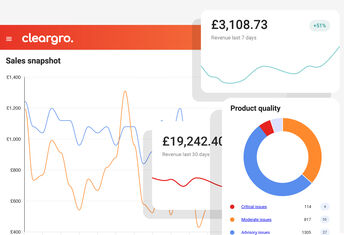In ecommerce, growth often feels synonymous with spending more – more on ads, more on traffic, more on new product launches. But one of the most reliable and sustainable ways to grow revenue sits within the inventory you already have.
Optimising existing product listings – ensuring they are accurate, descriptive, and visually compelling — can significantly improve SEO visibility, conversion rate, and profit margins, without adding a single new SKU.

1. Stronger SEO Through Higher Quality Product Listings
Search engines depend on structured, relevant data to understand and rank your products. Well-optimised listings – with descriptive titles, keyword-informed descriptions, and properly assigned categories – help search engines connect your products to high-intent searches.
The result: more qualified organic traffic. When every product page communicates exactly what’s being sold, search algorithms (and customers) can match it to the right query, improving visibility and reducing reliance on paid acquisition.
2. Higher Conversion Rates Through Better Content
Quality content is the bridge between a shopper’s intent and their purchase decision. Accurate, informative, and persuasive product descriptions build trust and remove uncertainty, while high-quality images convey value and reduce returns.
Optimising titles for clarity (not just keywords), writing descriptions that address buyer needs, and showcasing products from multiple angles all improve conversion rates. Shoppers buy faster – and with more confidence – when information is complete and credible.
3. Improved ROAS and Lower Ad Waste
Paid campaigns perform best when they lead to high-quality product pages. Poorly written titles or incomplete listings provide a poor landing page experience, increasing cost-per-click and reducing Return on Ad Spend (ROAS).
When your listings are optimised, every click is more likely to convert. This means more efficient use of ad budgets and improved profitability from the same marketing spend – a key advantage in a market where acquisition costs continue to rise.
4. Enhanced Customer Experience and Brand Trust
A consistent, high-quality catalogue communicates professionalism. Customers notice when product titles are accurate, descriptions are helpful, and images are clear and consistent. These details make the browsing and buying experience seamless, boosting satisfaction and loyalty.
When shoppers can trust your product information, they are more likely to return and recommend – reinforcing brand strength over time.
5. A Compounding Growth Effect
Unlike short-term marketing tactics, inventory optimisation compounds over time. Every product page you improve continues to deliver value – attracting organic traffic, improving conversions, and supporting paid campaigns long after the initial work is done.
It’s an investment in the foundation of your ecommerce operation – one that pays ongoing dividends across every marketing channel.
Sounds great, where do I start?
For ecommerce teams, knowing what to optimise – and where to start – can be the hardest part. That’s where Cleargro comes in. Cleargro integrates your ecommerce, analytics, and advertising data to automatically identify which products have the greatest potential to drive incremental revenue and profit. Its opportunity engine highlights underperforming listings and content weaknesses — so you can focus on the updates that will make the biggest impact.
Other news stories


